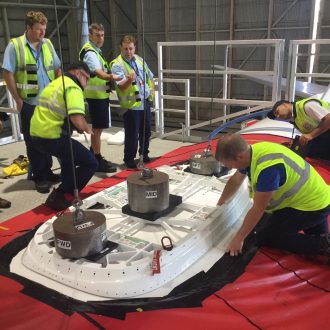Ever since we first switched on our first fast and free Wi-Fi on a single Boeing 737 in April 2017, take up from customers has skyrocketed.
Back then, around 32 per cent of customers on the aircraft named Mudgee logged on while travelling up and down the east coast, mostly to check emails or visit Facebook.
Fast forward seven years, Wi-Fi is enabled across our domestic fleet, and take up averages around 75 per cent on every flight – with some flights hitting above 100 per cent as customers log on to multiple devices. On our newest aircraft, the Airbus A220, the average uptake is more than 90 per cent on each flight.
As the percentage of customers who log on each flight has boomed, the way customers use the service has also evolved.

“When we first put it on it was just a means of keeping connected, mostly for business- travellers who might be going from Sydney to Melbourne for the day, and they might be completing presentations or other work,” according to Qantas Executive Manager for Product and Service, Phil Capps.
“Web browsing is now around 40 per cent of the activity, and we’re now seeing at least a quarter of customers using domestic Wi-Fi to stream video. We’re also seeing between 15 and 20 per cent of our domestic customers use Wi-Fi for audio streaming as well, driven by the popularity of Spotify and podcasts.
“So this shows that the expectation for Wi-Fi among our domestic travellers is not just for those on a business trip but very much for leisure too.”
Say hi to Wi-Fi on international flights too
Since the early days of Qantas Wi-Fi our customers have been asking for access on international services too.
The good news is we’re gearing up to start rolling out the fast and free service across the existing Qantas international fleet, which will be progressively switched on from the end of 2024.
And there’s a reason that it’s taken a while. We’ve been waiting until global satellite technology could deliver a similar quality connection to the one that Qantas domestic customers enjoy, even in areas of the world where it was previously impossible.
A partnership with global broadband company Viasat means that is now a reality. The first international aircraft to be fitted with the latest Viasat antenna was an A330-200LR aircraft, registration VH-EBN. This means customers will have access to the internet for the whole trip to Qantas’ Asian destinations.
Installation on our Boeing 787s and A380s and A330-300s will begin next year.
How to retrofit Wi-Fi on the Roo
While Qantas’ new 787s and A350s will arrive Wi-Fi ready, on older aircraft, retrofitting Wi-Fi is a fairly complex job. The first international A330-200 to be fitted with Wi-Fi was in the hangar for around three weeks completing the task.
Mr Capps said the biggest aircraft – the A380s – were the most challenging to retrofit.
“When we acquired the A380s it was before 2010 and the available on-air infrastructure was quite limited, so the work that’s involved in us now taking an A380 and fitting it with the latest gen Wi-Fi is considerably bigger,” he said.
“You have to essentially put a hole in the roof of the aircraft to install the radome and antenna to create that Wi-Fi environment. On the 787s which we acquired later, we provision the aircraft hull itself with enough infrastructure so at a later time when we wanted to put Wi-Fi in, we were on the way.”
And Mr Capps has a reassurance for the small number of customers who prefer a digital detox during flights. While the Wi-Fi will continue to be fast and free, it will never be compulsory.